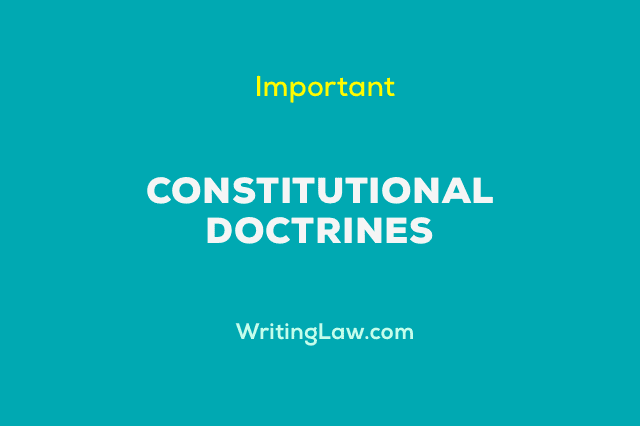
Doctrine means a belief or set of beliefs. In law, a doctrine is a legal rule, theory or principle, most likely established through precedents and using which judgments can be determined in a given legal case.
In this law note, let us learn about the six most important constitutional doctrines applied under the Indian Constitution:
1. Doctrine of Eclipse.
When a pre-constitutional law is inconsistent with fundamental rights, then the law altogether is not wiped out. Instead, it is “eclipsed“. This means the law becomes dormant and not dead for all purposes. If the said fundamental right is amended, in that case, the dormant law becomes active, and the shadow is removed to make the impugned Act free from all infirmities.
The doctrine applies only to pre-constitutional laws (Article 13(1)) and not post-constitutional laws (Article 13(2)). This is because pre-constitutional law was valid when enacted, and its validity supervened when the Constitution came into force. In contrast, post-constitutional laws infringing fundamental rights are null and void from their inception.
2. Doctrine of Severability.
As per Article 13 of the Indian Constitution, the law is void only to the extent of its contravention with fundamental rights. The part that is inconsistent with fundamental rights, if removed from the rest of the provision, then the rest remains valid and stands operative.
If the legislative intent is missing after removing the invalid part, in that case, the whole provision becomes void and ignored. The Hon’ble Supreme Court in Gopalan vs the State of Madras held that if the omission of the void portion does not change the nature, object or structure of the legislation, the latter is severable from the rest.
3. Doctrine of Judicial Review.
The power of judicial review is vested in the High Courts and Supreme Court under Article 226 and Article 32, respectively. This enables legislative action to be subjected to the scrutiny of superior courts, which is integral to our constitutional scheme.
Judicial Review is the power of courts to interfere with the constitutionality of the government’s legislative and executive actions and declare it null and void if it is inconsistent with the basic principles of constitutionality.
Legitimizing government actions and protecting the Constitution against undue encroachments by the government are the two prime interrelated functions under judicial review. Under this doctrine, the courts act as the supreme protector of the Constitution by keeping all the authorities (legislative, executive, administrative, quasi-judicial) within their legal bounds.
It is now well-settled as a result of the decision of the Hon’ble Supreme Court that:
Judicial review is a basic and essential feature of the Constitution. No law passed by Parliament in the exercise of its constituent power can abrogate it or take it away.
Parliament can undoubtedly set up effective alternative institutional mechanisms or arrangements for scrutinizing governmental actions and encouraging the doctrine of judicial review.
4. Doctrine of Pith and Substance.
The court applies the rule of pith and substance when a subject in one list touches a subject in another list. In determining whether a particular law relates to a particular subject mentioned in one list or the other, “pith and substance” is to be regarded as the true nature and character of law. The three main criteria for recognizing the pith and substance of law are the enactment as a whole, its main objectives, and the scope and objectives of its provisions.
5. Doctrine of Colorable Legislation.
The doctrine is based on the maxim that what cannot be done directly cannot be done indirectly. The doctrine applies when the legislature does something that cannot be done directly within its scope of power.
Relevancy of this doctrine depends on the competence and not motives/intentions (mala fide or bonafide) in making a law. It becomes irrelevant if the legislature concerned passes a law that is within its constitutional authority. The true nature and character of law are used to determine whether the legislature transgressed the restrictive powers assigned to him.
6. Doctrine of Harmonious Construction.
If certain provisions in the Constitution conflict with each other, then those provisions should be interpreted in a manner so as to give meaning to all. Interpretation should be in a broad and liberal manner giving effect to all its parts and the presumption indicating that its framers intended no conflict or repugnancy. The doctrine has been applied in various cases wherein there is a conflict or overlapping between entries in different lists.
Read Next:
1. What Is the Mini Constitution of India and Changes It Added
2. What Is the Doctrine of Restitution in Civil Procedure Code
- What Are the Rights of Private Sector Employees in India? - 4th April 2023
- Is an Unmarried Woman Legally Allowed To Have an Abortion in India? - 27th June 2022
- What Are the Two Main Schools and Four Sub-Schools Under Hindu Law? - 27th April 2022







